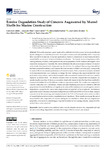Mostrar o rexistro simple do ítem
Erosive Degradation Study of Concrete Augmented by Mussel Shells for Marine Construction
| dc.contributor.author | Camba, C. | |
| dc.contributor.author | Mier, José | |
| dc.contributor.author | Carral Couce, Luis | |
| dc.contributor.author | Lamas, M.I. | |
| dc.contributor.author | Álvarez-Feal, José-Carlos | |
| dc.contributor.author | Díaz-Díaz, Ana-María | |
| dc.contributor.author | Tarrío-Saavedra, Javier | |
| dc.date.accessioned | 2022-01-18T17:00:14Z | |
| dc.date.available | 2022-01-18T17:00:14Z | |
| dc.date.issued | 2021-10 | |
| dc.identifier.citation | Camba, C.; Mier, J.L.; Carral, L.; Lamas, M.I.; Álvarez, J.C.; Díaz-Díaz, A.-M.; Tarrío-Saavedra, J. Erosive Degradation Study of Concrete Augmented by Mussel Shells for Marine Construction. J. Mar. Sci. Eng. 2021, 9, 1087. https://doi.org/10.3390/jmse9101087 | |
| dc.identifier.issn | 2077-1312 | |
| dc.identifier.uri | http://hdl.handle.net/2183/29415 | |
| dc.description.abstract | [Abstract] This work proposes a green material for artificial reefs to be placed in Galicia (northwest Spain) taking into account the principles of circular economy and sustainability of the ecosystem. New concrete formulations for marine applications, based on cement and/or sand replacement by mussel shells, are analyzed in terms of resistance to abrasion. The interest lies in the importance of the canning industry of Galicia, which generates important quantities of shell residues with negative environmental consequences. Currently, the tests to determine the abrasion erosion resistance of concrete on hydraulic structures involve large and complex devices. According to this, an experimental test has been proposed to estimate and compare the wear resistance of these concretes and, consequently, to analyze the environmental performance of these structures. First, a numerical analysis validated with experimental data was conducted to design the test. Subsequently, experimental tests were performed using a slurry tank in which samples with conventional cement and sand were partially replaced by mussel shell. The abrasive erosion effect of concrete components was analyzed by monitoring the mass loss. It shows an asymptotic trend with respect to time that has been modeled by Generalized Additive Model (GAM) and nonlinear regression models. The results were compared to concrete containing only conventional cement and sand. Replacing sand and/or cement by different proportions of mussel shells has not significantly reduced the resistance of concrete against erosive degradation, except for the case where a high amount of sand (20 wt.%) is replaced. Its resistance against the erosive abrasion is increased, losing between 0.1072 and 0.0310 wt.% lower than common concrete. In all the remaining cases (replacements of the 5–10 wt.% of sand and cement), the effect of mussel replacement on erosive degradation is not significant. These results encourage the use of mussel shells in the composition of concrete, taking into account that we obtain the same degradation properties, even more so considering an important residue in the canning industry (and part of the seabed) that can be valorized. | es_ES |
| dc.description.sponsorship | This research was funded by Xunta de Galicia through the project CN-10MMA003CT. This study was also funded through the collaboration agreement between Xunta de Galicia (Convenio de colaboración entre a Xunta de Galicia, a Universidade da Coruña e a Fundación da Universidade da Coruña para dar continuidade ao Proxecto de investigación de arrecife artificial—PROARR), Universidade da Coruña and the Universidade da Coruña Foundation (FUAC) to give continuity to the previous project. The research of Javier Tarrío-Saavedra has been supported by MINECO grant MTM2017-82724-R, Ministerio de Ciencia e Innovación grant PID2020-113578RB-100, and by the Xunta de Galicia (Grupos de Referencia Competitiva ED431C-2020-14 and Centro de Investigación del Sistema universitario de Galicia ED431G2019/01), all of them through the ERDF | |
| dc.description.sponsorship | Xunta de Galicia; 10MMA003CT | |
| dc.description.sponsorship | Xunta de Galicia; ED431C-2020-14 | |
| dc.description.sponsorship | Xunta de Galicia; ED431G2019/01 | |
| dc.language.iso | eng | es_ES |
| dc.publisher | MDPI | es_ES |
| dc.relation | info:eu-repo/grantAgreement/AEI/Plan Estatal de Investigación Científica y Técnica y de Innovación 2017-2020/MTM2017-82724-R/ES/INFERENCIA ESTADISTICA FLEXIBLE PARA DATOS COMPLEJOS DE GRAN VOLUMEN Y DE ALTA DIMENSION | |
| dc.relation | info:eu-repo/grantAgreement/AEI/Plan Estatal de Investigación Científica y Técnica y de Innovación 2017-2020/PID2020-113578RB-I00/ES/METODOS ESTADISTICOS FLEXIBLES EN CIENCIA DE DATOS PARA DATOS COMPLEJOS Y DE GRAN VOLUMEN: TEORIA Y APLICACIONES | |
| dc.relation.uri | https://doi.org/10.3390/jmse9101087 | es_ES |
| dc.rights | Atribución 4.0 Internacional | es_ES |
| dc.rights.uri | http://creativecommons.org/licenses/by/4.0/ | * |
| dc.subject | Marine construction | |
| dc.subject | Artificial reefs | |
| dc.subject | Concrete | |
| dc.subject | Abrasive erosion test | |
| dc.subject | Computational fluid dynamics modeling | |
| dc.subject | Degradation | |
| dc.subject | Statistical learning | |
| dc.subject | GAM | |
| dc.subject | Functional data analysis | |
| dc.title | Erosive Degradation Study of Concrete Augmented by Mussel Shells for Marine Construction | es_ES |
| dc.type | info:eu-repo/semantics/article | es_ES |
| dc.rights.access | info:eu-repo/semantics/openAccess | es_ES |
| UDC.journalTitle | Journal of Marine Science and Engineering | es_ES |
| UDC.volume | 9 | es_ES |
| UDC.issue | 10 | es_ES |
| dc.identifier.doi | 10.3390/jmse9101087 |
Ficheiros no ítem
Este ítem aparece na(s) seguinte(s) colección(s)
-
GI-CIM - Artigos [27]
-
CIT-GEM - Artigos [21]
-
CIT- PROTERM - Artigos [6]
-
GI-SISTER - Artigos [37]
-
GI-MODES - Artigos [142]






